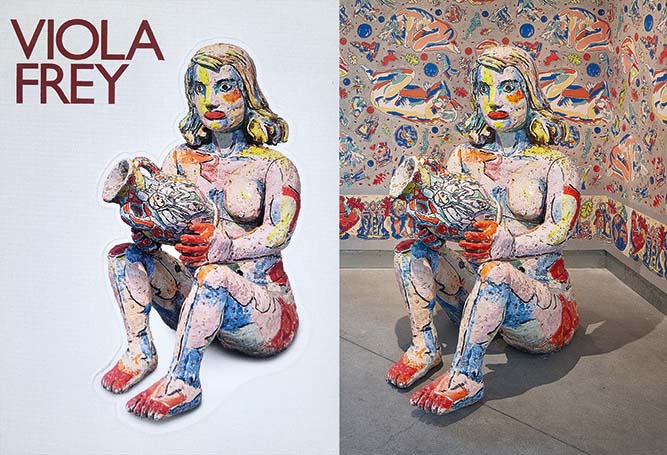
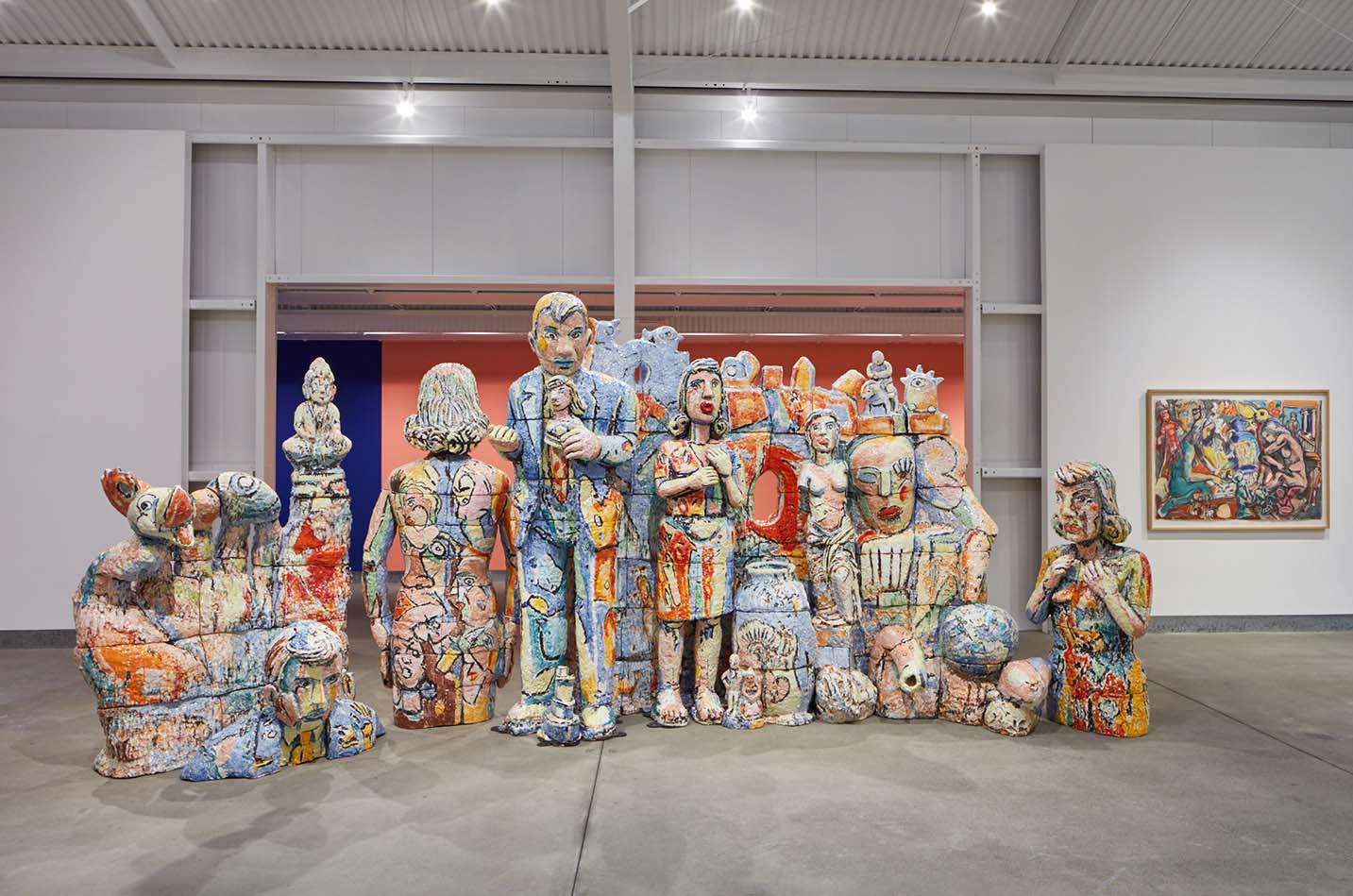
In 2019, the di Rosa Center for Contemporary Art in California presented Viola Frey: Center Stage, the artist’s first institutional survey on the West Coast since 1981. Long overdue, the show unfolded as a sweeping excavation of more than a hundred works spanning five decades—illuminating the breadth of her practice, yet exposing a muted shortcoming. Pressed for time, the organizers had forgone a supplemental catalog—its absence exposing an acute necessity: a dedicated book, a definitive reference encompassing her life and oeuvre, unveiling dimensions few had ever seen.
Not even many of her Bay Area friends and colleagues who attended the survey had fully grasped her boundless complexity and range, admitting “I had no idea” again and again, whilst metaphysically reacquainting with Frey. Although best known for her towering clay figures, her practice extends to equally exquisite paintings, photographs, bronzes, and beyond—interwoven with recurring iconography, symbols, and references, all calling to be mapped. Thus, the idea materialized and, in 2024, manifested as the first monograph on the seminal artist: Viola Frey: Artist’s Mind / Studio / World, published by the Artists’ Legacy Foundation (ALF) and Gregory R. Miller & Co.
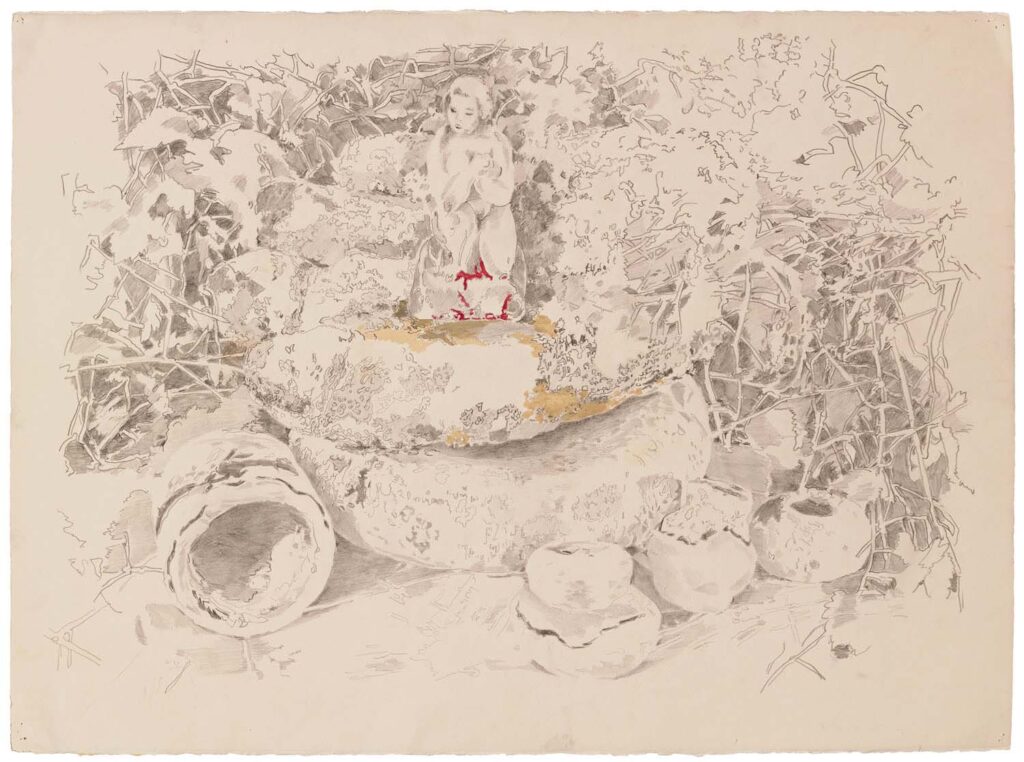
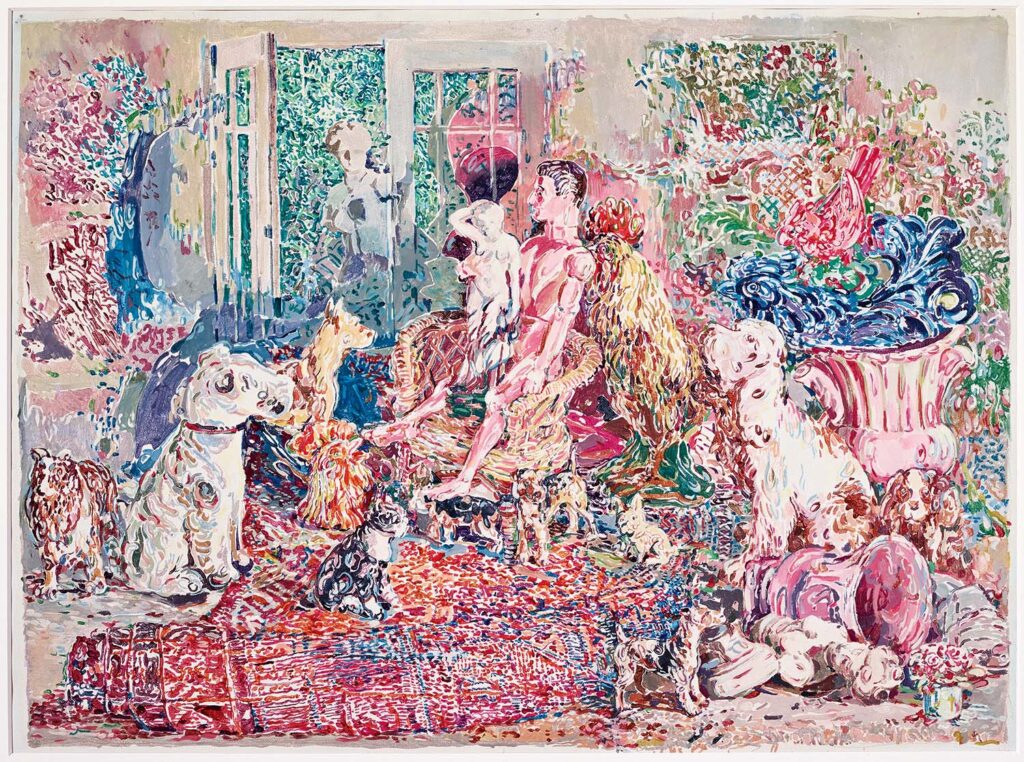
Although the idea technically transpired in 2019, the meat of the book had been brewing for a decade plus. Since 2013, Cynthia de Bos, Director of Collections and Archives, has been researching, fielding, and archiving thousands of materials related to the artist—access made possible only through Frey’s endowment to the foundation upon her death in 2004. That act had been set in motion years earlier when, in 2000, Frey co-founded ALF with Squeak Carnwath and Gary Knecht to support living artists through awards and grants whilst promoting and protecting artistic legacies after death.
Since its establishment, the foundation has not only awarded hundreds of thousands to artists but has, for Frey, realized dozens of exhibitions after her passing—continuing to uphold her legacy and, ultimately, bringing this book to life.
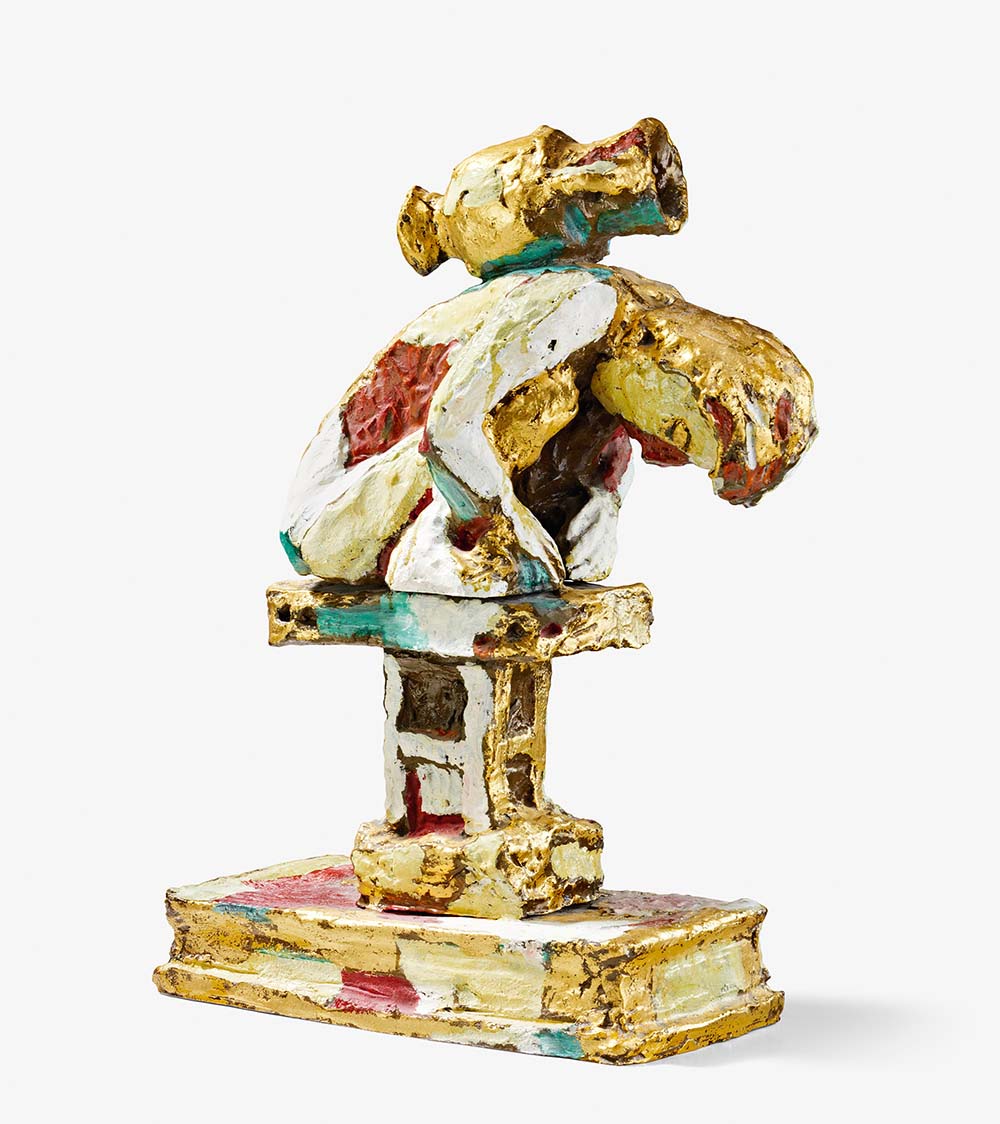
The monograph is ever so gorgeous—a linen-white cover with a debossed image of a woman fixed in an indecipherable gaze, holding a vase glazed in vivid oranges and reds, pastel yellows and pinks, shadowy blues, and sliced with black demarcations: the piece, Seated Figure. The endpapers are coated in a maximalist mélange of naked men and women folded fetally, figurines, tchotchkes, ornaments, and more—a whimsical medley of color and form drawn from a 1991 silkscreen (now available as wallpaper through Flavor Paper). Serendipitously, both Seated Figure and the wallpaper were on view together at the di Rosa Center survey—a happenchance homage to the book’s conceptual birthplace.
Less serendipitously, the wallpaper bears the same title—Artist’s Mind / Studio / World—a phrase embedded in the etymology of Frey’s visual language, reaching back to a series of late ’80s drawings that share its namesake. “It wasn’t until the late ’80s and early ’90s that she actually started calling out those areas of interest in the titles of her artwork,” de Bos recalls. Yet the title extends beyond mere labels—it shapes the very framework of the book itself.
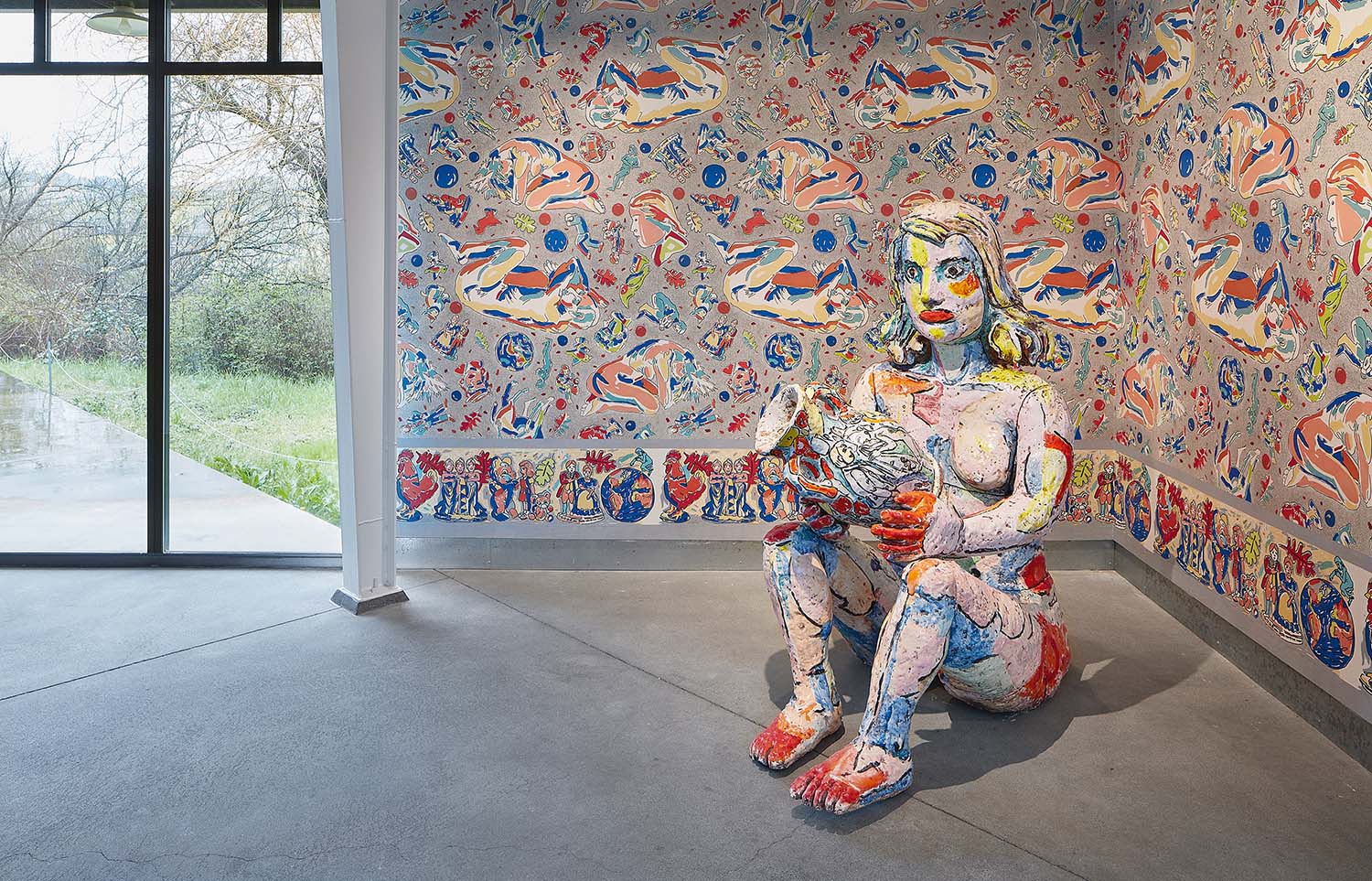
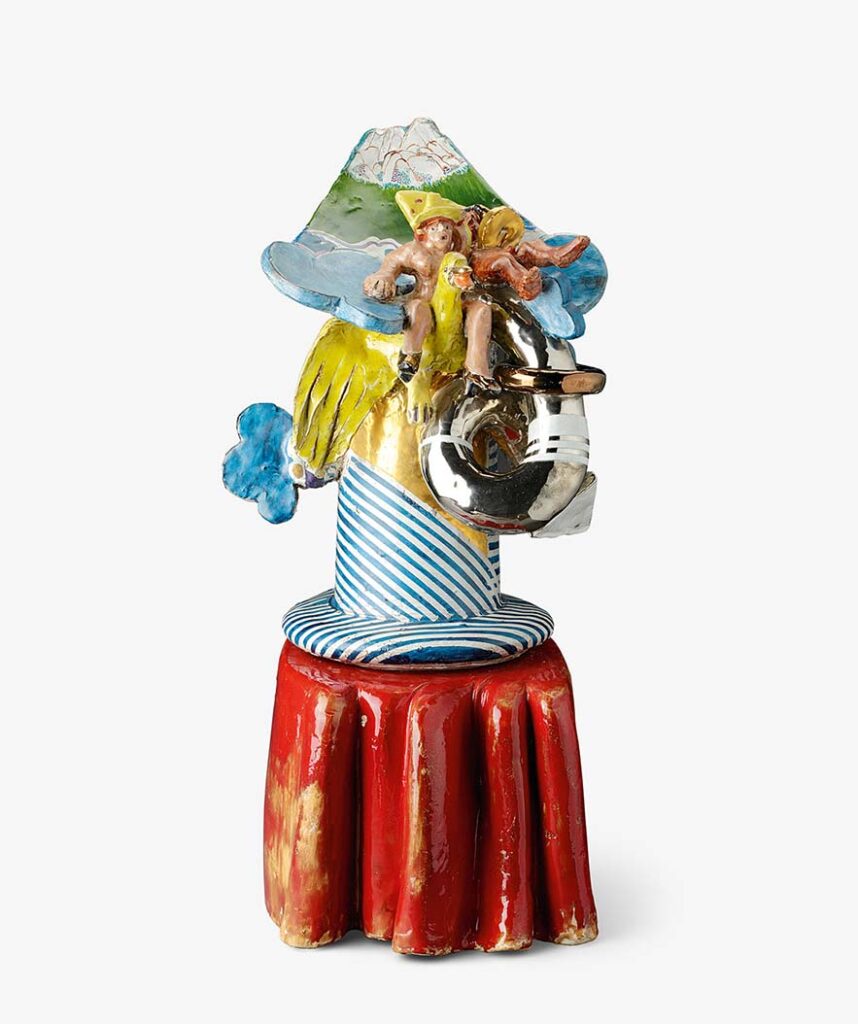
During the embryonic stages of development, there were lingering questions about how the monograph should be structured. Working closely with designer Conny Purtill and co-editor, curator, and writer Jenelle Porter, de Bos and the team chose to divorce from the traditional linear chronology, arranging the book instead around three thematic segments that mirror the early, middle, and late chapters of Frey’s career. The Mind: tracing the formative years that molded the artist’s vision. The Studio: her pivotal space of work and home. The World: both how she saw it and how it came to see her. Each section is accompanied by full-page images of her ceramics, paintings, photographs, and intimate snapshots from its respective period, with the meticulous chronology—spearheaded by de Bos—intermittently interspersed throughout the book, anchoring the three essays that not only explore each theme but also reveal the interplay and interchangeability between them.
The book blossoms with the first essay, “Origin Story: Viola Frey and Finding a Language,” by Nancy Lim (associate curator of painting and sculpture at the San Francisco Museum of Modern Art), who, after digging through ALF’s archives, pieced into coherence an early life rarely written about—creating the scaffolding for the two essays that follow. Lim uncovers Frey’s childhood on a six-acre grape farm in California’s Central Valley, her early proclivity for junk collecting, her formative art school years, and her longtime companionship with Charles Fiske, with whom she articulated and refined the language of her art. Woven together, Lim’s essay focuses on the period leading up to the 1980s, painting a vivid portrait of Frey as a daughter, student, thinker, and artist in formation.
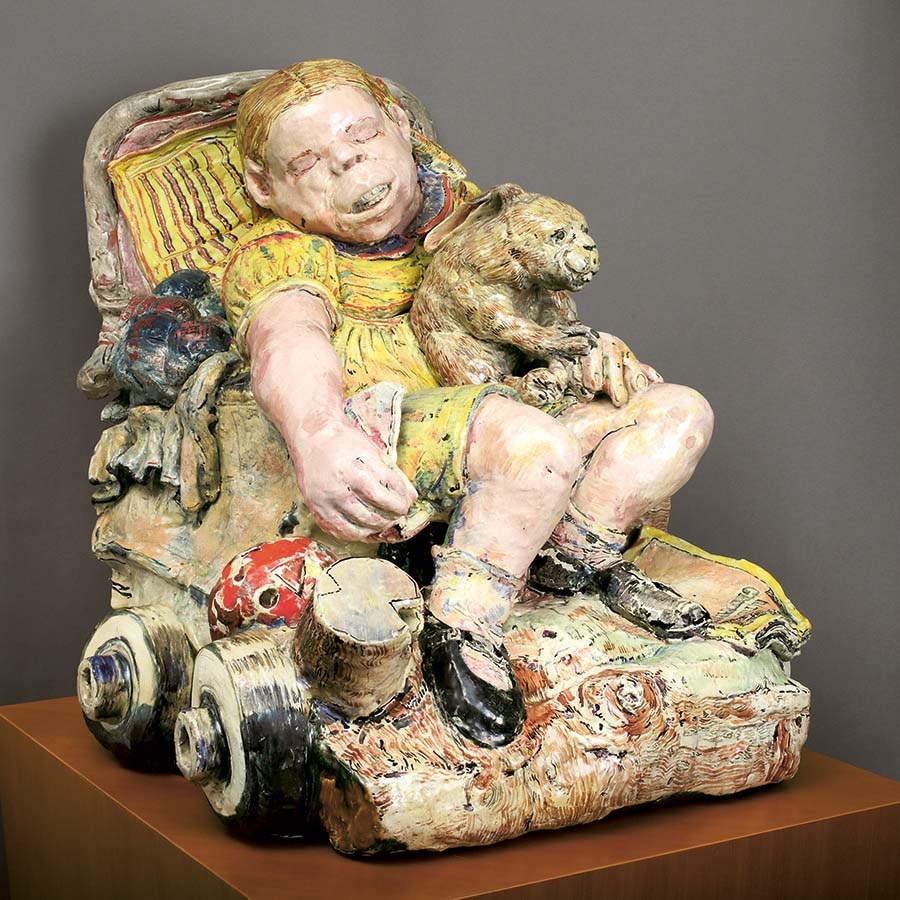
Jodi Throckmorton (chief curator at the John Michael Kohler Arts Center) delves into the next era, tracing how Frey’s work evolved as she moved from studio to studio—her sculptures growing larger and more ambitious—culminating in the pivotal 1975 purchase of a Georgian Colonial home that she transformed into a live-in studio. Archival photographs capture intimate moments: paintings hung salon-style, colossal ceramics rising like edifices in her backyard. Her house, crowded with figurines and objects, began to resemble the Alameda Flea Market she so often frequented, as she gathered tchotchkes that later surfaced as tableaux in many of her lesser-seen works. For more than thirty years, the studio became her world—a sanctum where she reflected, created, and probed the wider world beyond “663 Oakland Avenue, Oakland, California.”
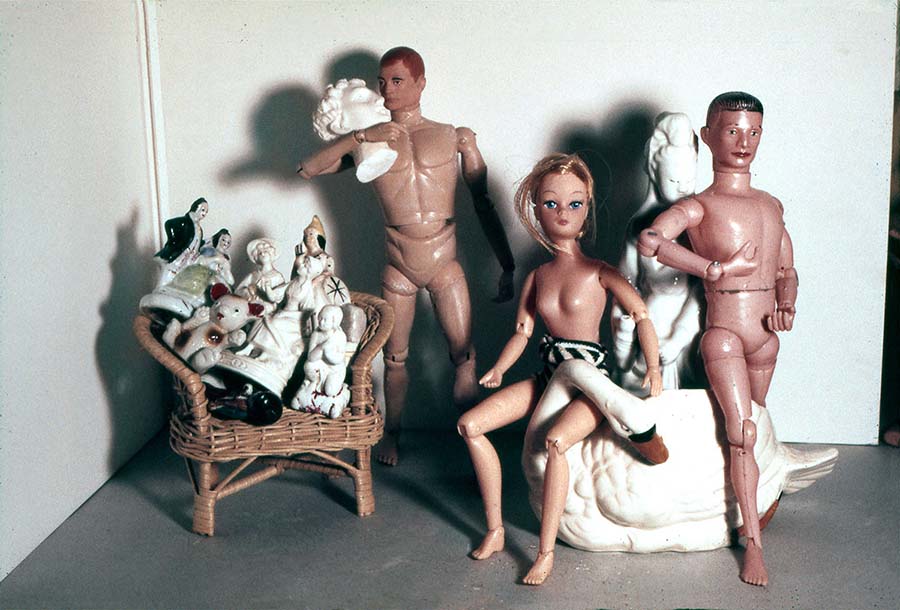

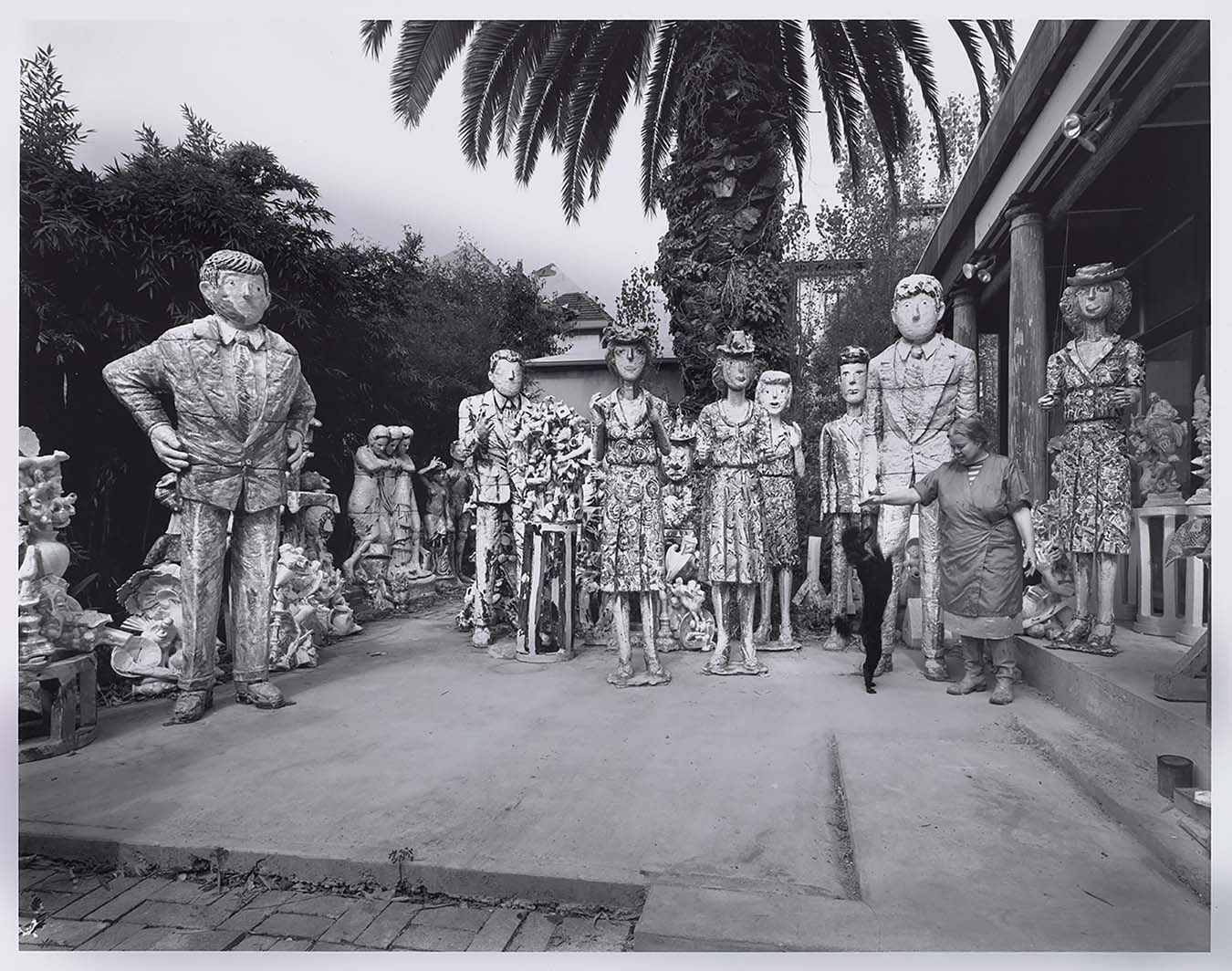
Flowering into the final essay, Jenelle Porter’s “The World and the Woman” examines the historical, cultural, societal, and moral forces that formed Frey’s work. Key moments—such as the 1969 moon landing, postwar throwaway culture, the endangerment of species, the HIV/AIDS pandemic, and, perhaps most notably, gender politics—are all refracted through Frey’s lens. Porter also reflects on how the world, in turn, saw Frey and the artists she influenced, including Ann Agee, Simone Leigh, and Kathy Butterly (recipient of the 2007 ALF Award), amongst others. Together, Porter, Throckmorton, and Lim underscore why Frey was, and remains, a singularly significant artist—her legacy reverberating across generations and resounding through the oscillating terrains of clay.

And now, we’ve witnessed a gargantuan shift: ceramics has surged to an unimaginable level of popularity, and Frey’s work sits in a radically different context. “I really do feel that ceramics has a role, if it will take up its responsibility of teaching ceramics as art,” Frey remarked. Decades later, her credo rings clairvoyant. She not only instilled this belief in her students—urging them to think beyond clay’s conventional, utilitarian limits—but through her tenacious creative commitment, she helped push the medium’s pendulum from functional to sculptural. The book is not merely a handsome object or a collection of stunning images to admire; it honors Frey’s legacy, offering the most comprehensive resource to date on an artist whose immeasurable imagination contributed to clay’s transformation from a pre-20th-century craft into the linchpin of contemporary art it is today.
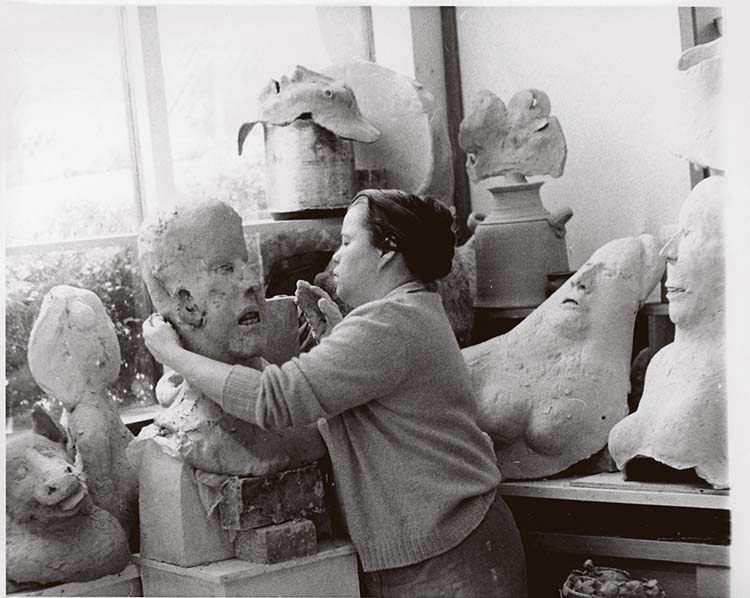

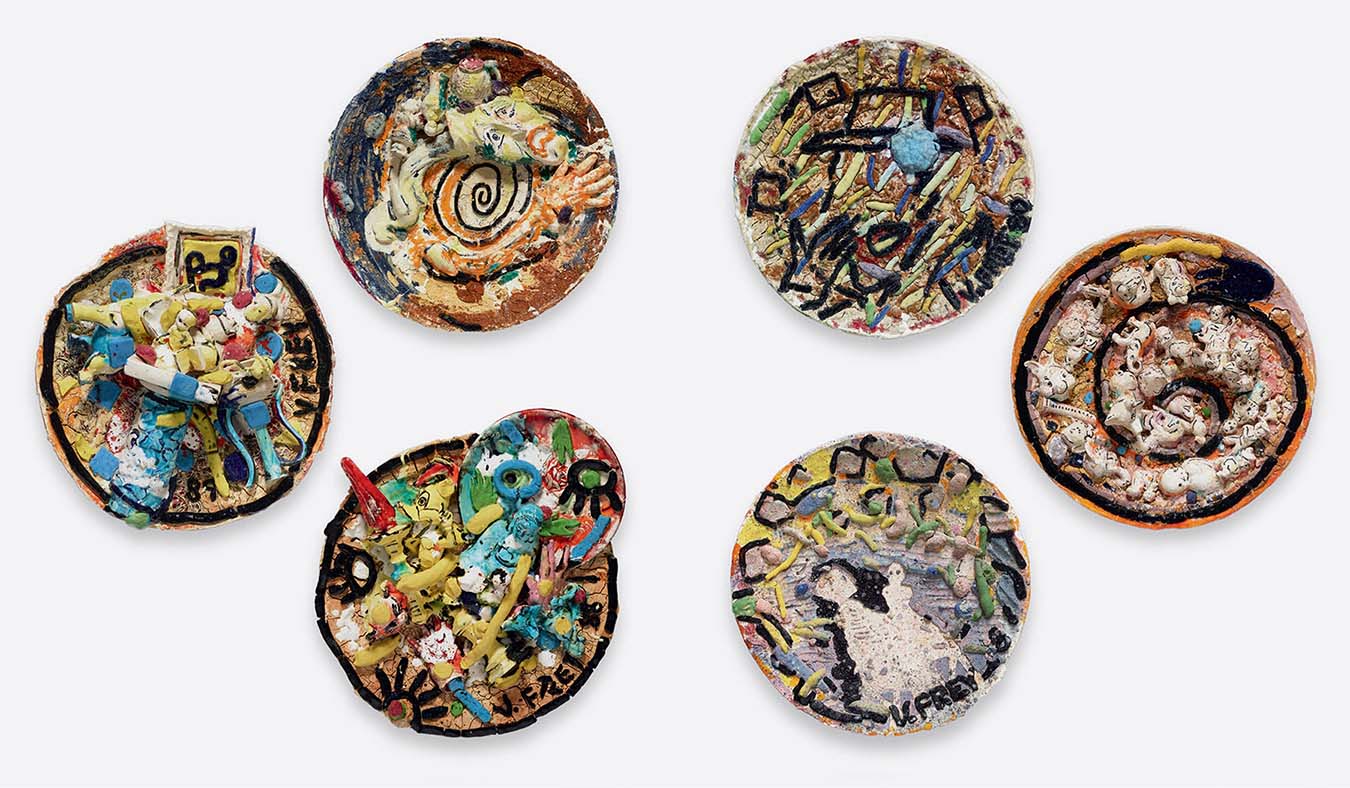

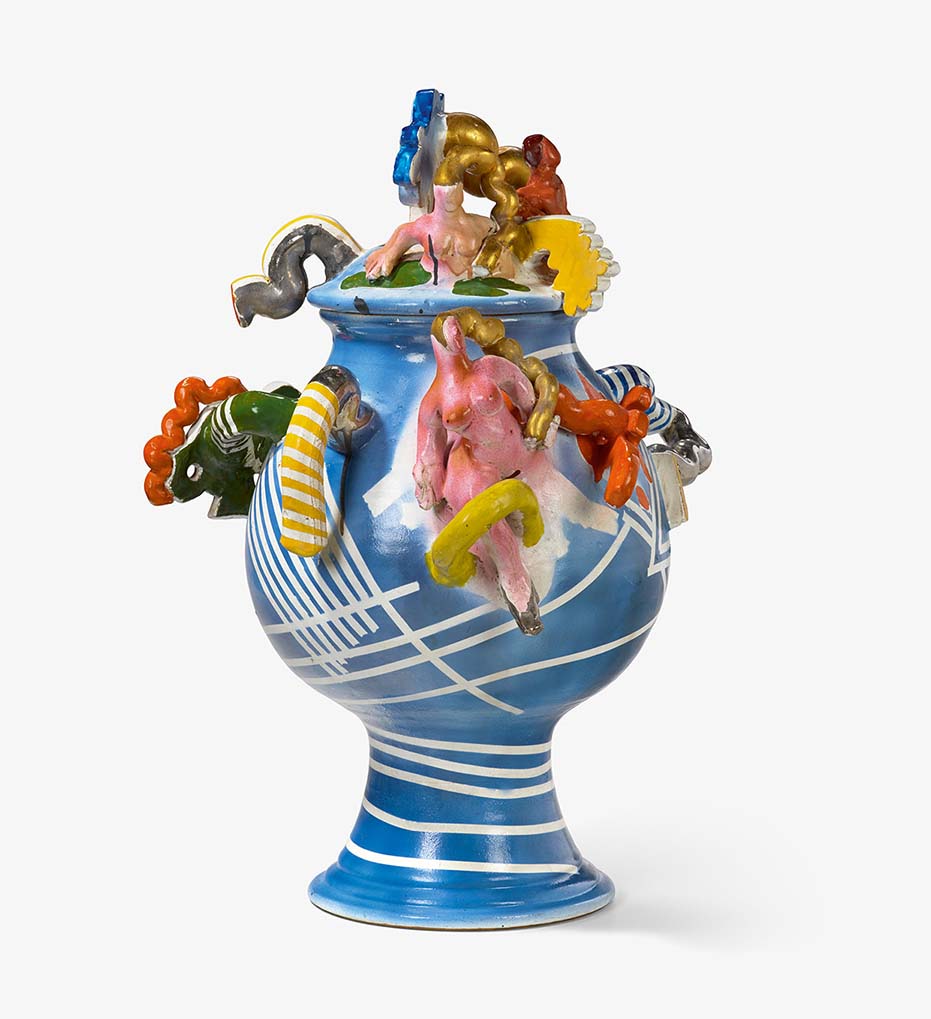
Find Viola Frey: Artist’s Mind / Studio / World at ArtBook.
Learn more about the Artists’ Legacy Foundation’smission and initiatives, and visit Viola Frey’s websitefor more about the artist and future events.
Through November 16, 2025
Sèvres Extraordinaire! Sculpture from 1740 until Today (catalogue)
Bard Graduate Center Gallery, New York, NY
Through February 28, 2026
Monumental: Larger than Life-Size
Racine Art Museum, Racine, WI
November 8, 2025 – March 5, 2028
A Shared Journey: The Barkan Contemporary Ceramic Collection at the RISD Museum (catalogue)
RISD Museum, Providence, RI
January 10, 2025 – April 5, 2026
Viola Frey: Foundations
Bedford Gallery, Walnut Creek, CA
Publication Date: Late 2026
GLOBAL CERAMICS: CONCURRENT HISTORIES AND TRADITIONS
By Dr. Prudence Rice, Professor Emerita in Anthropology at Southern Illinois University, and Matt Wilt, Head of Ceramics at Skidmore College
